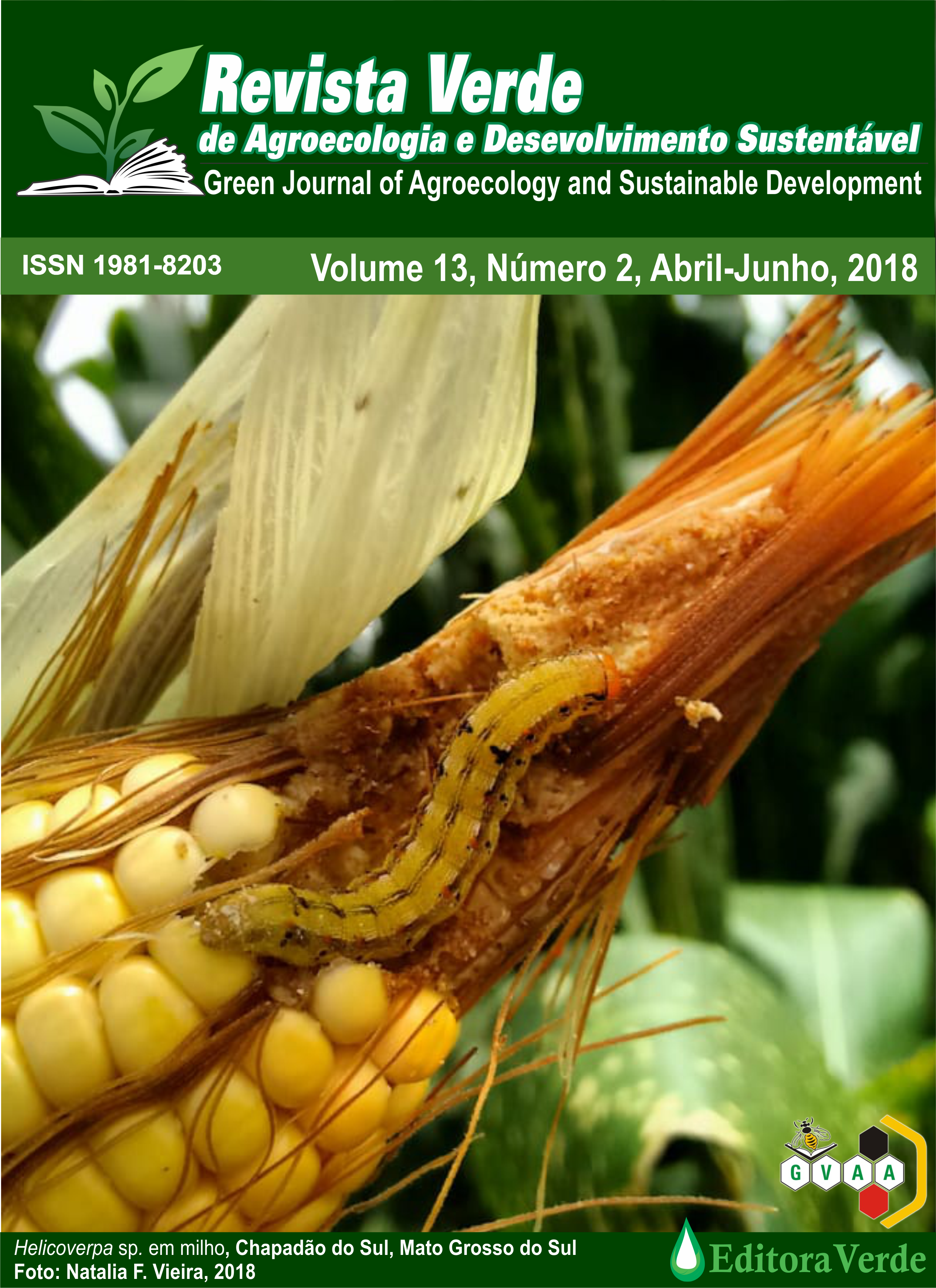Progeny coriander resistant root-knot nematode
DOI:
https://doi.org/10.18378/rvads.v13i2.5441Keywords:
Coriandrum sativum L., Meloidogyne incognita race 1, Plant breeding.Abstract
Coriander is a important vegetable crop in Brazil, being widely consumed as a condiment and cultivated mainly in North and Northeast brasilian regions. Diseases caused by Meloidogyne species are one main causers damages of crop. In the literature there is no reported about identification nematoid resistant coriander genotypes. In this study was carried the reaction evaluation of a heat-tolerant coriander population regarding resistance to Meloidogyne incognita race 1. Forty-six progenies of half-sibs were evaluated in a randomized block design, with three replications, the plot consisting of six plants. After 15 days of sowing the plants were inoculated using 1500 eggs of pathogen per plant. Evaluation occurred 45 days after inoculation, where evaluated characteristics were galls incidence, number of galls in washed root system and number of eggs per plant. Excepting incidence of galls, all variables presented significant difference by the F test, allowing the selection of 31 progenies according to the scale proposed by Oostenbrink. Phenotypic and genetic correlations between number of galls in root system and number of eggs were significant.Downloads
References
ALMEIDA, D. Manual de culturas hortícolas. 1.ed. Lisboa: Editorial Presença, 2006. 346p.
BIONDI, C. M.; PRADO, M. D. C.; MEDEIROS, J. E.; PEDROSA, E. M. R.; MOURA, R. M. Tolerância do coentro ao parasitismo do nematoide Meloidogyne incognita raça 1. Nematologia Brasileira, Piracicaba, v.25, n.2, p.239-241, 2001.
BONETI, J. I. S.; FERRAZ, S. Modificação do método de Hussey & Barker para extração de ovos de Meloidogyne exígua de raízes de cafeeiro. Fitopatologia Brasileira, Brasília, v.6, n.3, p.533, 1981.
BORÉM, A.; MIRANDA, G. V. Melhoramento de plantas. 6.ed. Viçosa: Ed. UFV, 2013. 523 p.
CRUZ, C. D. GENES: o software package for analysis in experimental statistics and quantitative genetics. Acta Scientiarum, Maringá, v.35, n.3, p.271-276, 2013.
DIEDERICHSEN, A. Coriander Coriandrum sativum L. Edinburgh: University Press, 1996. 83p.
DINIZ, G. M. M. Resistência do coentro (Coriandrum sativum L,) à Meloidogyne incognita (Raça 1 e 3) e Meloidogyne javanica. 2012. 56f. Dissertação (Mestrado em Melhoramento Genético de Plantas) – Universidade Federal Rural de Pernambuco, Recife. 2012.
FALUBA, J. S.; MIRANDA, G. V.; LIMA, R. O.; SOUZA, L. V.; DEBEM, E. A.; OLIVEIRA, A. M. C. Potencial genético da população de milho UFV 7 para o melhoramento em Minas Gerais. Ciência Rural, Santa Maria, v.40, n.6, p. 1250-1256, 2010.
FERRAZ, L. C. C. B.; BROWN, D. J. F. Nematologia de plantas: fundamentos e importância. Manaus: Norma Editora, 2016. 251 p.
FERREIRA, S.; GOMES, L. A. A.; GASPARINO, C. F.; CARVALHO FILHO, J. L. S.; MALUF, W. R. Caracterização de famílias F2:3 de alface para resistência ao nematoide das galhas. Revista Agrogeoambiental, Pouso Alegre, v.5, n.2, p.35-42, 2013.
HUSSEY, R. S.; BARKER, K. R. A comparison of methods colleting inocula of Meloidogyne spp. including a new technique. Plant Disease Reporter, v.57, p.1025-1028, 1973.
INMET. Instituto nacional de meteorologia. 2016. Disponível em: http://www.inmet.gov.br/portal/index.php?r=bdmep/bdmep. Acesso em: 04 Abr. 2016.
NEFFATI, M.; SRITI, J.; HAMDAOUI, G.; KCHOUK, M. E.; MARZOUK, B. Salinity impact on fruit yield, essential oil composition and antioxidant activities of Coriandrum sativum fruit extracts. Food Chemistry, [S.l.], v.124, n.1, p. 221-225, 2011.
OLIVEIRA, C. M. G. Palestra: Panorama das doenças e pragas em horticultura, doenças causadas por nematoides. Biológico, São Paulo v.69, n.2, p.85-86, 2007.
OLIVEIRA, E. Q.; BEZERRA NETO, F. B.; NEGREIROS, M. Z.; BARROS JÚNIOR, A. P.; FREITAS, K. K. C.; SILVEIRA, L. M.; LIMA, J. S. S. Produção e valor agroeconômico no consórcio entre cultivares de coentro e de alface. Horticultura Brasileira, Brasília, v.23, n.2, p.285-289, 2005.
OLIVEIRA, N. S.; CARVALHO FILHO, J. L. S.; SILVA, D. O.; PASTORIZA, R. J. G.; MELO, R. A.; SILVA, J. W.; MENEZES, D. Seleção e parâmetros genéticos de progênies de coentro tolerantes ao calor. Horticultura Brasileira, Vitória da Conquista, v.33, n.3, p.319-323, 2015.
OOSTENBRINK, M. Major characteristics of the relation between nematodes and plants. Mededelingen Van De landbouwhogeschool, Nederland, v.66, n. 4, p.1-46, 1966.
PINHEIRO, J. B.; PEREIRA, R. B. Manejo de nematoides na cultura do coentro e salsinha. Brasília: Embrapa Hortaliças, 2016. 10p.
SAMOJLIK, L.; LAKIC, N.; MIMICA-DUKIC, N.; DAKOVIC-SVAJCER, K.; BOZIN, B. Antioxidant and hepatoprotective potential of essential oils of coriander (Coriandrum sativum L,) and caraway (Carum carvi L,) (Apiaceae). Journal of Agricultural and Food Chemistry, [S.l.], v.58, n.15, p.8848-8853, 2010.
TIHOHOD, D. Nematologia agrícola aplicada. 2.ed. Jaboticabal: FUNEP, 2000. 372p.
WESEMAEL, W. M. L.; VIAENE, N.; MOENS, M. Root-knot nematodes (Meloidogyne spp.) in Europe. Nematology, [S.l.], v.13, n.1, p.3-16, 2011.













